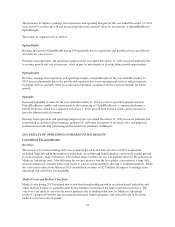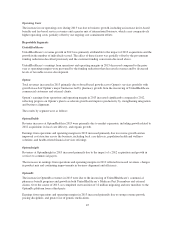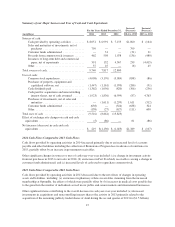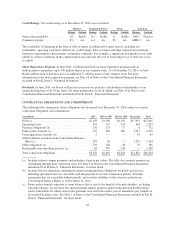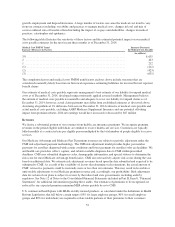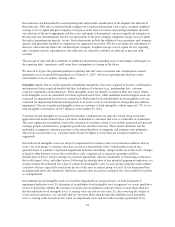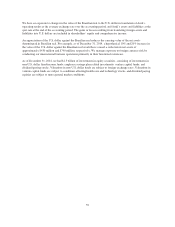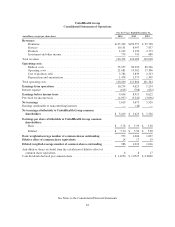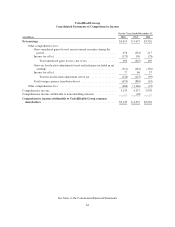United Healthcare 2014 Annual Report Download - page 56
Download and view the complete annual report
Please find page 56 of the 2014 United Healthcare annual report below. You can navigate through the pages in the report by either clicking on the pages listed below, or by using the keyword search tool below to find specific information within the annual report.Discount rates are determined for each reporting unit and include consideration of the implied risk inherent in
their forecasts. This risk is evaluated using comparisons to market information such as peer company weighted
average costs of capital and peer company stock prices in the form of revenue and earnings multiples. Beyond
our selection of the most appropriate risk-free rates and equity risk premiums, our most significant estimates in
the discount rate determinations involve our adjustments to the peer company weighted average costs of capital
that reflect reporting unit-specific factors. Such adjustments include the addition of size premiums and company-
specific risk premiums intended to compensate for apparent forecast risk. We have not made any adjustments to
decrease a discount rate below the calculated peer company weighted average cost of capital for any reporting
unit. Company-specific adjustments to discount rates are subjective and thus are difficult to measure with
certainty.
The passage of time and the availability of additional information regarding areas of uncertainty with respect to
the reporting units’ operations could cause these assumptions to change in the future.
We elected to bypass the optional qualitative reporting unit fair value assessment and completed our annual
quantitative tests for goodwill impairment as of January 1, 2015. All of our reporting units had fair values
substantially in excess of their carrying values.
Intangible Assets. Our recorded separately-identifiable intangible assets were acquired in business combinations
and represent future expected benefits but they lack physical substance (e.g., membership lists, customer
contracts, trademarks and technology). These intangible assets are initially recorded at their fair values. Finite-
lived intangible assets are amortized over their expected useful lives, while indefinite-lived intangible assets are
evaluated for impairment on at least an annual basis. Both finite-lived and indefinite-lived intangible assets are
evaluated for impairment between annual periods if an event occurs or circumstances change that may indicate
impairment. Our most significant intangible assets are customer-related intangibles, which represent 71% of our
total intangible asset balance of $3.7 billion as of December 31, 2014.
Customer-related intangible assets acquired in business combinations are typically valued using an income
approach based on discounted future cash flows attributable to customers that exist as of the date of acquisition.
The most significant assumptions used in the valuation of customer-related assets include: projected revenue and
earnings growth, retention rates, perpetuity growth rates and discount rates. These initial valuations and the
embedded assumptions contain uncertainty to the extent that those assumptions and estimates may ultimately
differ from actual results (e.g., customer turnover may be higher or lower than the assumed retention rate
suggested).
Our finite-lived intangible assets are subject to impairment tests when events or circumstances indicate that an
asset’s (or asset group’s) carrying value may exceed its estimated fair value. Consideration is given on a
quarterly basis to a number of potential impairment indicators including: changes in the use of the assets, changes
in legal or other business factors that could affect value, experienced or expected operating cash-flow
deterioration or losses, adverse changes in customer populations, adverse competitive or technological advances
that could impact value, and other factors. Following the identification of any potential impairment indicators, we
would calculate the estimated fair value of a finite-lived intangible asset (or asset group) using the undiscounted
cash flows that are expected to result from the use of the asset or related group of assets. If it is determined that
an impairment exists, the amount by which the carrying value exceeds its estimated fair value would be recorded
as an impairment.
Our indefinite-lived intangible assets are tested for impairment on an annual basis, or more frequently if
impairment indicators exist. To determine if an indefinite-lived intangible asset is impaired, we assess qualitative
factors to determine whether the existence of events and circumstances indicates that it is more likely than not
that the indefinite-lived intangible asset’s carrying value exceeds its fair value. If, after assessing the totality of
events and circumstances, we conclude that it is not more likely than not that the indefinite-lived intangible
asset’s carrying value exceeds its fair value, no impairment exists and no further testing is performed. If we
54


